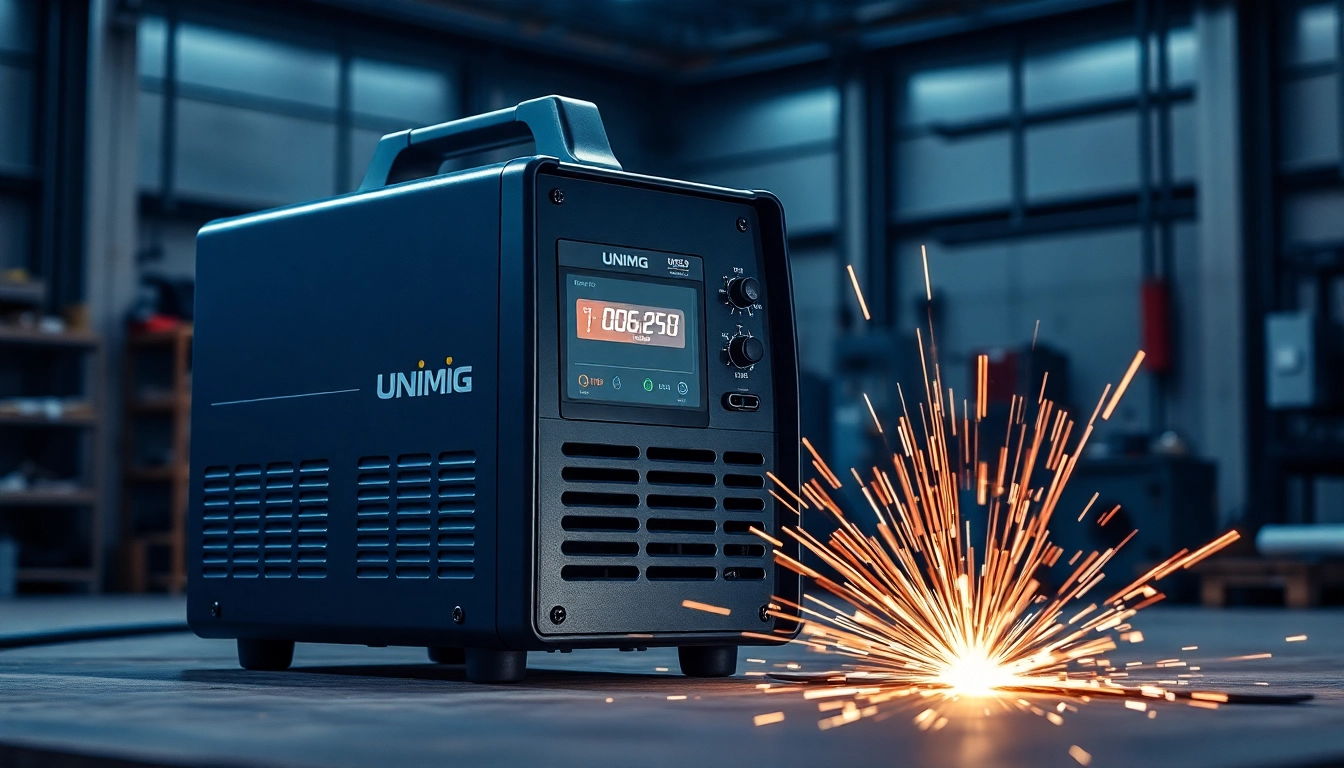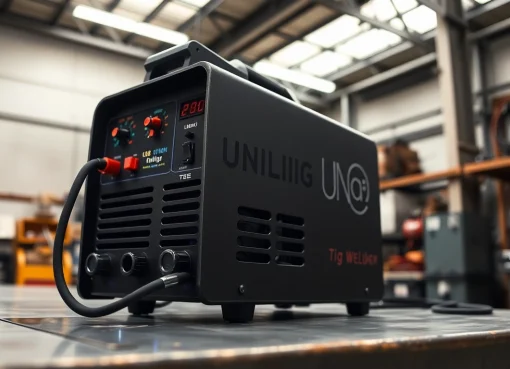Enhancing Your Metalwork with the Unimig TIG Welder: A Comprehensive Guide

Understanding the Unimig TIG Welder
TIG welding, or Tungsten Inert Gas welding, represents a sophisticated method of joining metal that is known for its precision and versatility. At the heart of this process is the unimig tig welder. These welders have garnered attention for their reliable performance and user-friendly features, making them suitable for both hobbyists and professionals alike. In this article, we will delve deep into the functionalities, advantages, and accessories associated with Unimig TIG welders, assisting you in making informed decisions whether you’re new to the field or looking to upgrade your equipment.
What is a TIG Welder?
A TIG welder uses a non-consumable tungsten electrode to produce the weld. In this process, a flow of inert gas, typically argon or helium, shields the weld area from oxidation and contamination, resulting in high-quality, precise welds. Unlike other welding techniques, such as MIG (Metal Inert Gas), TIG welding allows for greater control over the weld pool, making it ideal for thin materials and detailed work. This precision makes it a popular choice in industries that require high aesthetic standards, such as automotive and aerospace, as well as artistic metalworking.
Key Features of Unimig TIG Welders
When considering a Unimig TIG welder, several key features stand out:
- AC/DC Capability: Many Unimig models can handle both alternating and direct current welding, enabling them to work with a variety of materials, including aluminum, steel, and stainless steel.
- High-Frequency Start: This feature allows for a smooth arc start, crucial for delicate welding applications.
- Pulsing Option: Pulse welding capabilities allow for better control over heat input, ideal for thin sheets or intricate designs.
- Adjustable Settings: Users benefit from various adjustments, including current output and frequency, enabling customization for specific material needs.
- Portable Design: Many Unimig models are lightweight and easy to transport, making them suitable for fieldwork and on-site projects.
Benefits of Using a Unimig TIG Welder
Choosing a Unimig TIG welder comes with its advantages:
- Precision: The control offered by TIG welding minimizes spatter and produces cleaner welds, enhancing the overall quality of the work.
- Versatility: The ability to weld various materials and thicknesses makes it a go-to tool for different applications, from craft projects to industrial fabrication.
- Durability: Unimig welders are built to last, often featuring robust designs that withstand heavy use.
- Ease of Use: With features like adjustable controls and clear displays, Unimig welders are user-friendly, even for novices.
- Cost Efficiency: The long-term durability and versatility of Unimig TIG welders can lead to savings, as they reduce the need for multiple machines.
Selecting the Right Unimig TIG Welder for Your Needs
When venturing into the world of TIG welding, selecting the right tool is crucial. With several models available, such as the Viper and Razor series, understanding your specific requirements will guide your choice.
Comparing Models: Viper vs. Razor
Both the Viper and Razor series of Unimig TIG welders are designed with different user needs in mind:
- Viper Series: Typically geared towards hobbyists and lighter industrial applications, Viper models come with user-friendly interfaces and onboard guides that facilitate easy operation. They are excellent for those who are new to TIG welding.
- Razor Series: Aimed primarily at professional users, Razor machines offer enhanced features and greater versatility for a wider range of applications. They tend to feature more robust build quality and performance metrics suited for intensive welding tasks.
Choosing between the two ultimately comes down to your level of experience, the types of projects you intend to undertake, and how often you plan to use the welder.
Factors to Consider When Choosing
Several factors play a pivotal role in selecting the right Unimig TIG welder:
- Material Types: Consider what materials you will primarily be working with, as some welders are better suited for specific metals.
- Welding Thickness: Different models accommodate various thicknesses, so assess your project requirements.
- Budget: While investing in quality equipment is important, it’s also crucial to choose a welder that fits within your financial constraints.
- Portability: If you’ll be moving the welder frequently, look for lightweight models or those designed for easy transport.
- Brand Support: Opt for brands known for excellent customer service and easy access to replacement parts or accessories.
Best Practices for Unimig TIG Welder Selection
To maximize your welding experience, consider these best practices:
- Research: Explore forums, product reviews, and videos to gain insights from other users.
- Test Before Buying: If possible, test different models at a local tool store to determine comfort and usability.
- Consult Experts: Seeking advice from professionals or educators in welding can provide direction tailored to your needs.
- Warranty and Service: Check for warranties or service plans that help safeguard your investment and peace of mind.
Essential Accessories for Unimig TIG Welders
Having the right accessories can significantly enhance your welding experience. Here are essential items you should consider when using a Unimig TIG welder.
Must-Have Welding Gear
Your welding arsenal should include:
- Protective Gear: Invest in high-quality gloves, helmets, and aprons that are rated for TIG welding. Proper gear is vital for safety.
- Tungsten Electrodes: Purchase a variety of tungsten electrodes suitable for different metals and thicknesses.
- Filler Rods: Ensure you have the correct filler rods for the materials you work with.
- Welding Cart: A cart can organize and transport your welder and accessories efficiently.
Optional Accessories to Enhance Performance
Beyond basic gear, consider these optional accessories:
- Foot Pedal: A foot pedal provides better control over the welding process, allowing for seamless adjustments while working.
- Cooler Unit: For high-duty cycle operations, a cooler unit can protect your welder from overheating.
- Gas Regulators: Having spare regulators can ensure you have a consistent gas supply and pressure during welding.
Maintenance Tools for Longevity
To maintain your Unimig TIG welder and maximize its lifespan, consider including these maintenance tools:
- Cleaning Brushes: Regular cleaning of the torch and nozzles prevents contamination and ensures smooth performance.
- Toolkits: A comprehensive toolkit helps in performing regular maintenance and addressing minor issues effectively.
TIG Welding Techniques with a Unimig Welder
Whether you are a beginner or an experienced machinist, mastering TIG welding techniques is critical for achieving exceptional results.
Beginner Techniques for Effective Welding
Beginners should focus on the basics:
- Understanding the Machine: Familiarize yourself with your welder’s settings, including amperage and gas flow rates.
- Maintaining Proper Torch Angle: Keeping the torch at an angle of approximately 15 degrees allows for better control of the arc.
- Practice on Scrap Metal: Before starting a project, practice on scrap pieces to build confidence and accuracy.
Advanced TIG Welding Tips
For those looking to refine their skills, consider these advanced tips:
- Pulsing Techniques: Use pulsing to control heat and minimize warping or burning through the material, especially on thinner gauges.
- Travel Speed: Adjust your travel speed based on the material’s thickness; faster movement can help prevent too much heat exposure.
- Fitting and Joint Preparation: Make sure joints are clean and well-fitted to reduce defects and achieve strong welds.
Common Mistakes and How to Avoid Them
Avoiding pitfalls is essential for welding success:
- Incorrect Amperage Settings: Always set your amperage according to the material thickness to avoid burn-through.
- Inconsistent Gas Flow: Ensure your gas flow is steady and sufficient throughout the welding process.
- Neglecting Safety Gear: Always wear appropriate safety gear to protect against potential hazards.
Maximizing Efficiency and Safety While Welding
Efficiency and safety go hand-in-hand in welding. By following safety protocols and optimizing your workspace, you can enhance both aspects of your welding tasks.
Safety Gear for TIG Welding
Investing in the right safety gear is crucial. Essential gear includes:
- Welding Helmet: A proper helmet protects your eyes from UV light and sparks.
- Protective Gloves: High-temperature gloves prevent burns and provide a good grip on the torch.
- Respirators: If welding in enclosed spaces, consider using a respirator to avoid inhaling harmful gases.
Optimizing Your Workspace
An organized workspace can enhance your efficiency:
- Clear Area: Ensure your workspace is free of clutter to prevent trip hazards.
- Good Lighting: Proper lighting is essential for visibility and precision in TIG welding.
- Ventilation: Ensure good airflow to dissipate fumes, which can otherwise be harmful to your health.
Monitoring and Adjusting Settings for Best Results
Keep a close eye on your settings during welding:
- Regular Checks: Frequently check gas pressure and amperage settings, especially when switching between materials.
- Evaporation Rate: Monitor the cooling rate to optimize your weld quality and integrity.
- Feedback Loop: Regularly assess your welds and adjust settings based on the results for continuous improvement.



Leave a Comment